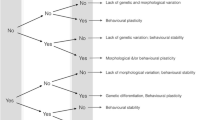Abstract
The patterns and correlates of aggressionwithin andbetween actively speciating subterranean mole rats of theSpalax ehrenbergi superspecies in Israel were tested in an attempt to approach an evolutionary theory of aggression related to both adaptation and speciation. Laboratory experiments were conducted on 314 adult mole rats (188 males and 126 females) caught in nature, representing 12 populations and comprising four chromosomal species (2n = 52, 54, 58, 60). The present analysis concentrates on “total aggression” comprising four aggressive variables: attacks, bitings, head-ons and sniffing with open mouth, out of 23 recorded variables. The results indicate that (a) aggression is distributed as a multipeak, discontinuous phenotypic parameter, displaying polymorphism within all 12 populations and 4 species tested; (b) the level of aggression was higher in males than in females, in the breeding than in the nonbreeding season, and displayed clinal geographic variation in both sexes across the superspecies range, where “militancy” increased northwards; (c) aggression was significantly correlated with ecological, physiological, genetical and ethological factors. These results support an evolutionary theory of aggression related to the intertwined processes of adaptation and speciation.
Similar content being viewed by others
References
Arieli R, Arieli M, Heth G and Nevo E 1984 Adaptive respiratory variation in four chromosomal species of mole rats.Experientia 40: 512–514
Barigozzi C (ed.) 1982Mechanisms of speciation (New York: Alan R Liss)
Ebert P D and Hyde J S 1976 Selection for agonistic behavior in wild femaleMus musculus.Behav. Genet. 6: 291–304
Guttman R, Naftali G and Nevo E 1975 Aggression patterns in three chromosome forms of the mole rat,Spalax ehrenbergi. Anim. Behav. 23: 485–493
Haim A, Heth G, Pratt H and Nevo E 1983 Photoperiodic effects on thermoregulation in a blind subterranean mammal.J. Exp. Biol. 107: 59–64
Heth G and Nevo E 1981 Origin and evolution of ethological isolation in subterranean mole rats.Evolution 35: 259–274
Heth G, Frankenberg E and Nevo E 1986 “Courtship” call of subterranean mole rats (Spalax ehrenbergi): Physical analysis. J. Mammal. (in press)
Kessler S, Elliott G R, Orenberg E K and Barchas G D 1977 A genetic analysis of aggression behavior in two strains of mice.Behav. Genet. 7: 313–321
Maxson S C 1981 The genetics of aggression in vertebrates. InThe biology of aggression eds) P F Brain and D Benton (Amsterdam: Sythoff and Noordhoff) pp. 69–102
Maynard Smith J and Price G R 1973 The logic of animal conflict.Nature (London) 246: 15–18
Miller R S 1967 Patterns and process in competition.Adv. Ecol. Res. 4: 1–74
Nevo E 1961 Observations of Israeli populations of the mole ratSpalax ehrenbergi Nehring 1898.Mammalia 25: 127–144
Nevo E 1979 Adaptive convergence and divergence of subterranean mammals.Annu. Rev. Ecol. Syst. 10: 269–308
Nevo E 1982 Speciation in subterranean mammals. InMechanisms of speciation (ed.) C Barigozzi (New York: Alan R Liss) pp. 191–218
Nevo E 1985 Speciation in action and adaptation in subterranean mole rats: Patterns and theory. InAnimal speciation and contact zones (ed.) V Sbordoni, Special volumeBoll. Zool. 52: 65–95
Nevo E 1986a Evolutionary behavior genetics in active speciation and adaptation of fossorial mole rats. InProc. Int. Conf. Variability and Behavioural Evolution, Rome, November 1983 (Rome: Acad. Naz. Lincei) (in press)
Nevo E 1986b Mechanisms of adaptive speciation at the molecular and organismal levels. InEvolutionary processes and theory eds) S Karlin and E Nevo (New York: Academic Press) pp. 439–474
Nevo E and Bar-El H 1976 Hybridization and speciation in fossorial mole rats.Evolution 30: 831–840
Nevo E and Cleve H 1978 Genetic differentiation during speciation.Nature (London) 275: 125–126
Nevo E and Shaw C R 1972 Genetic variation in a subterranean mammal.Biochem. Genet. 7: 235–241
Nevo E and Shkolnik A 1974 Adaptive metabolic variation of chromosome forms in mole rats,Spalax. Experientia 30: 724–726
Nevo E, Naftali G and Guttman R 1975 Aggression patterns and speciation.Proc. Natl. Acad. Sci. USA 72: 3250–3254
Nevo E, Bodmer M and Heth G 1976 Olfactory discrimination as an isolating mechanism in speciating mole rats.Experientia 32: 1511–1512
Nevo E, Guttman R, Haber M and Erez E 1979 Habitat selection in evolving mole rats.Oecologia 43:125–138
Nevo E, Guttman R, Haber M and Erez E 1982a Activity patterns in evolving mole rats.J. Mammal. 63: 453–463
Nevo E, Heth G and Beiles A 1982b Population structure and speciation in mole rats.Evolution 36: 1283–1289
Nevo E, Beiles A, Heth G and Simson S 1986a Adaptive differentiation of body size in speciating mole rats.Oecologia (in press)
Nevo E, Heth G and Beiles A 1986b Sexual polymorphism of the dear enemy phenomenon: Aggression within populations of subterranean mole rats. (in preparation)
Nevo E, Heth G, Beiles A and Frankenberg E 1986c Geographic dialects in blind subterranean mammals: The role of vocal communication in active speciation.Proc. Natl. Acad. Sci. USA (submitted)
O’Donald P 1980Genetic models of sexual selection (Cambridge: University Press)
Riechert S E and Hammerstein P 1983 Game theory in the ecological context.Annu. Rev. Ecol. Syst. 14: 377–409
SPSS-X 1983User’s guide (New York: McGraw Hill)
Wahrman J, Goitein R and Nevo E 1969 Mole ratSpalax: Evolutionary significance of chromosome variation.Science 164: 82–84
Author information
Authors and Affiliations
Rights and permissions
About this article
Cite this article
Nevo, E., Heth, G. & Beiles, A. Aggression patterns in adaptation and speciation of subterranean mole rats. J. Genet. 65, 65–78 (1986). https://doi.org/10.1007/BF02923537
Received:
Issue Date:
DOI: https://doi.org/10.1007/BF02923537




